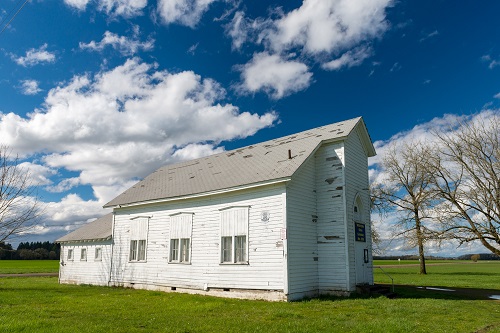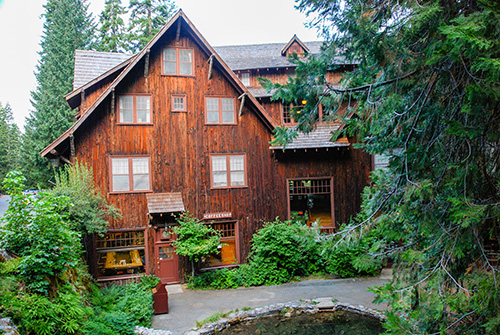
The Western Star Oakville Grange in Linn County. (Oregon Scenic Images collection)
The Western Star Oakville Grange in Linn County. (Oregon Scenic Images collection)Some Oregonians worried about the effects of these transformations: the potential exhaustion of natural resources, the concentrated power of political and economic actors, community and social disruption, and more. They had a different vision for Oregon, and at the end of the 1800s and beginning of the 1900s, they tried to reform Oregon politics, government, society and environments. Many of these efforts originated among farmers and workers who experienced first-hand the transformation of Oregon’s environments.
Frustrated with high interest rates on bank loans, expensive shipping costs, and the low prices their crops got at market, farmers joined the Patrons of Husbandry—the Grange, established in 1873—and local chapters of the Farmers’ Alliance, an advocacy organization that appeared in Oregon in 1891. Laborers in Oregon’s cities, forests, farms, mines and fisheries had their own frustrations, including low pay, poor and often dangerous working conditions and long hours. Beginning in 1880, White workers organized into chapters of the Knights of Labor, a union that advocated for better pay and working conditions, and also supported legislation and violence directed against Chinese workers. Entrenched political and economic interests stymied these reform organizations, and so these farmers and workers stepped into Oregon politics with the formation of the People’s Party, or Populists, in 1892 and the Union Party in 1899. The People’s Party quickly fragmented and disintegrated, but enthusiasm for reform continued and grew. In the 1910s, reformers secured a series of transformative laws, including the initiative and referendum process, direct election of senators, and the recall of elected officials. This package of reforms became known as the Oregon System — a set of political tools that put more power directly in the hands of the electorate.
 Women gained the right to vote in Oregon in 1912. Efforts then shifted to women's suffrage on the national stage. Above, first in 1912, and then in 1916, suffragists stopped in Pendleton during the Pendleton Round-Up rodeo and gave rousing speeches from automobiles. Learn more about women's suffrage in Oregon and nationally.
Women gained the right to vote in Oregon in 1912. Efforts then shifted to women's suffrage on the national stage. Above, first in 1912, and then in 1916, suffragists stopped in Pendleton during the Pendleton Round-Up rodeo and gave rousing speeches from automobiles. Learn more about women's suffrage in Oregon and nationally.During the first two decades of the 1900s, activists used the Oregon System to implement a variety of reforms. Voters approved initiatives that taxed telephone, telegraph and railroad companies, prohibited railroads from bribing public officials with free passes and regulated shipping rates. Oregon established a minimum wage, workers’ compensation, an eight-hour work day for public works projects and maximum hours and other protections for women workers. Some reformers also tried to address broader social issues with anti-prostitution and gambling campaigns, and, most famously and controversially, the prohibition of alcohol by constitutional amendment in 1914. Women led the prohibition campaign and many other reform efforts that sought to improve their communities by encouraging safer, more sanitary and more healthy environments. Through the Woman’s Christian Temperance Union, the Oregon Federation of Women’s Clubs and other organizations, as well as individually, women reformers asserted a powerful role in public life. In contrast to the racism and nativism that sometimes paired with Progressive Era reform efforts, the movement for women’s suffrage in Oregon relied on partnerships between White women and women of color in groups such as the Colored Women’s Equal Suffrage Association. The struggle to secure the right of women to vote took decades, failing five times before finally succeeding by initiative in 1912, eight years before it passed nationally. Women’s suffrage represented perhaps the most significant reform, while other ambitious and even radical efforts failed or quickly faded away. Despite long and intense efforts, advocates of the “single tax”—a 100% tax on the unearned value and profits on land—failed every time they went to the ballot. The Socialist Party of Oregon found limited but often enthusiastic support, especially in Portland and in southwestern Oregon; the citizens of Coquille, for example, elected a socialist mayor, although the party’s statewide efforts had little success. Though not quite the radical transformation that some Oregonians wanted, reform efforts significantly changed Oregon society.

The Chateau at Oregon Caves National Monument in the Siskiyou Mountains. (Oregon Scenic Images collection)
The Chateau at Oregon Caves National Monument in the Siskiyou Mountains. (Oregon Scenic Images collection)Oregonians also directed reform efforts toward the state’s environments. Reformers believed that Oregon’s forests, fisheries and other natural resources should be conserved and preserved for the public good, rather than exclusively possessed and exploited by private individuals and companies. The Oregon Land Fraud Trials (1904–1910) led to the prosecution of private speculators, government employees and elected officials who had abused homestead laws to illegally claim public land in Oregon and then sell it cheaply to timber and livestock companies. In 1911, the state legislature created the Oregon Board of Forestry and Department of Forestry, tasked with reducing forest fires, encouraging reforestation and enforcing other conservation measures. The federal government assisted reform efforts by setting aside land for preservation and conservation: it established Crater Lake National Park (1902) and Oregon Caves National Monument (1909), returned unsold Oregon & California Railroad land grants to the government (1914) and created millions of acres of national forest reserves. Reformers focused on Oregon’s oceans and rivers, too, asserting open public access to the state’s beaches (1913) and passing initiatives meant to conserve fish populations on the Rogue and Columbia Rivers.
Even as they slowed or stopped some transformations of Oregon’s environments, reformers encouraged other “improvements.” These changes were particularly visible on the Columbia River, where the Army Corps of Engineers completed the Cascade Locks in 1896 and Celilo Locks and Canal in 1916 to improve navigation and shipping. Reclamation projects—draining swampy land or irrigating dry land to “reclaim” it for farming—had an even greater effect in southern Oregon. Beginning in 1905, the federal Bureau of Reclamation built a complex system of dams, ditches, canals and other mechanisms that created more than 200,000 acres of farmland in the Klamath Basin while damaging the basin’s wetland ecosystems. The Klamath Irrigation Project and Columbia River locks and canals set the stage for even more ambitious reconfigurations of river systems later in the century. These developments, coupled with successful reform efforts, reinforced the view that Oregonians could and should control the state’s environments.
Next: World War I and Reactionary Oregon >